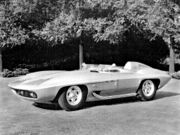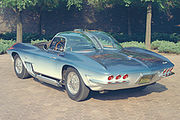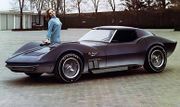Chevrolet Corvette
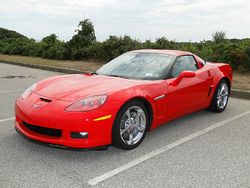 2010 Chevrolet Corvette Grand Sport 2010 Chevrolet Corvette Grand Sport |
|
| Manufacturer | Chevrolet Division General Motors Company |
|---|---|
| Also called | Sting Ray (1963–1967) Stingray (1969–1976) |
| Production | 1952–present |
| Model year(s) | C1 1953–1962 C2 1963–1967 C3 1968-1982 C4 1984-1996 C5 1997-2004 C6 2005-present |
| Assembly | Flint, Michigan, United States St. Louis, Missouri, United States Bowling Green, Kentucky, United States |
| Class | Sports car |
| Body style(s) | 2-door convertible 2-door coupé |
| Layout | FR layout |
The Chevrolet Corvette is sports car produced by the Chevrolet division of General Motors. The first model was designed by Harley Earl and introduced at the GM Motorama in 1953. Myron Scott is credited for naming the car after the Corvette, a small, maneuverable warship.[1] It has been produced in six generations in coupe, convertible, t-top coupe, and targa coupe body styles. Originally built in Flint, Michigan and St. Louis, Missouri, the Corvette is currently built in Bowling Green, Kentucky and is the official sports car of the Commonwealth of Kentucky. The National Corvette Museum documents the car's worldwide history and hosts an annual National Corvette Homecoming. The Auto Editors of Consumer Guide stated: "Plenty of sports cars would come and go over the course of the last five decades; the Corvette not only survived, but thrived, outlasting and out-pacing the competition."[2] In 2003, the Corvette became the first and only American sports car to celebrate its 50th anniversary.[3]
Contents |
Generations
The Corvette generations are referred to as C1 through the current C6.
C1 generation (1953-1962)
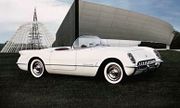
The first generation Corvette was introduced late in the 1953 model year and ended in 1962. These cars are often referred to as the "solid-axle" models since the independent rear suspension did not debut until the 1963 Sting Ray. 300 hand-built polo white Corvettes were produced for the 1953 model year, making it the rarest and one of the most sought after of all Corvettes. The 1955 model saw the introduction of the 265 cu in (4.34 L) V8 engine offered as an option, however the first seven off the production line featured the standard "Blue Flame" Inline-6. The origin of the Chevrolet Nomad station wagon was a two-door estate concept car built off a 1954 Corvette.
A new body was introduced for the 1956 model featuring a new "face" and side coves; the taillight fins were gone. An optional fuel injection system was made available in the middle of the 1957 model year. It was one of the first mass-produced engines in history to reach 1 bhp (0.75 kW) per cubic inch (16.4 Cubic cm) and Chevrolet's advertising agency used a "one hp per cubic inch" slogan for advertising the 283 bhp (211 kW) 283 cu in (4.64 L) Small-Block engine. Other options included power windows (1956), hydraulically operated power convertible top (1956), four speed manual transmission (late 1957), and heavy duty brakes and suspension (1957).

The 1958 Corvette received a body and interior freshening including quad headlights, bumper exiting exhaust tips, and a new steering wheel and dashboard, with all gauges mounted directly in front of the driver. Exclusive to the 1958 model were hood louvers and twin trunk spars. The 1959-60 model years had few changes except a decreased amount of body chrome and more powerful engine offerings.
For 1961, a complete redesign was made to the rear of the car; a "duck tail" with four round lights. The light treatment would continue for all following model year Corvettes. In 1962, the Chevrolet 283 cu in (4.64 L) Small-Block was enlarged to 327 cu in (5.36 L) and produced a maximum of 340 bhp (250 kW) making it the fastest of the C1 generation. 1962 was the last year for the wrap around windshield, solid rear axle, and convertible-only body style. The trunk lid and exposed headlights did not reappear for many decades.
C2 generation (1963-1967)
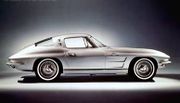
The second generation of the Corvette, referred to as mid-year's, was designed by Larry Shinoda with major inspiration from a previous concept design called the "Q Corvette" by Peter Brock and Chuck Pohlmann under the styling direction of Bill Mitchell. The design had several inspirations. The first was the contemporary Jaguar E-Type, one of which Bill Mitchell owned and enjoyed driving frequently. Mitchell also sponsored a car known as the "Mitchell Sting Ray" in 1959 because Chevrolet no longer participated in factory racing. This vehicle had the largest impact on the styling of this generation, although it had no top and did not give away what the coupe would look like. The third inspiration was a Mako Shark Mitchell had caught while deep-sea fishing.
Production started for the 1963 model year and ended in 1967. Introducing a new name, "Sting Ray", the 1963 model was the first year for a Corvette coupe and it featured a distinctive split rear window treatment (a feature that reappeared on the 1971 Buick Riviera). The Sting Ray featured hidden headlamps, non-functional hood vents, and an independent rear suspension.[4] Duntov never liked the split rear window because it blocked rear vision, but Mitchell thought it to be a key part of the entire design. Maximum power for 1963 was 360 bhp (270 kW) and was raised to 375 bhp (280 kW) in 1964. Options included electronic ignition, the breakerless magnetic pulse-triggered Delcotronic first offered on some 1963 Pontiac models.[5] On 1964 models the decorative hood vents were eliminated and Duntov got his way with the split rear window changed to a full width window.
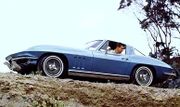
Four-wheel disc brakes were introduced in 1965, as was a "big block" engine option, the 396 cu in (6.49 L) V8. Side exhaust pipes were also optional in 1965 and continued through 1967. The introduction of the 425 bhp (317 kW) 396 cu in (6.49 L) big block in 1965 spelled the beginning of the end for the Rochester fuel injection system. The 396 cu in (6.49 L) option cost US$292.70 while the fuel injected 327 cu in (5.36 L) engine cost US$538.00. Few people could justify spending US$245.00 more for 50 bhp (37 kW) less, even if the FI cars offered optional bigger brakes not available on carbureted models.[4] With only 771 fuel-injected cars built in 1965, Chevrolet discontinued the option the following year. Chevrolet would up the ante in 1966 with the introduction of an even larger 427 cu in (7.00 L) Big Block version, creating what would be one of the most collectible Corvettes ever. Other options available on the C2 included the Wonderbar auto-tuning AM radio, AM-FM radio (mid 1963), air conditioning (late 1963), a telescopic steering wheel (1965) and headrests (1966).
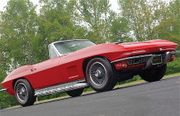
1967 was the final year for the C2 generation. It featured restyled fender vents, less ornamentation and the first use of all four taillights in red; back-up lamps were now rectangular, centrally located. (The all-four red taillight treatment continued on the first C3 in 1968 only and returned on the first C4 in 1984, continuing on all Corvettes since). 1967 had the first L88 engine option which was rated at 430 bhp (320 kW), but unofficial estimates place the actual output at 560 bhp (420 kW) or more.[6] Only twenty such engines were installed at the factory. From 1967 (to 1969), the Holley triple two-barrel carburetor, or Tri-Power, was available on the 427 L89 (a US$368 option, on top of the cost for the high-performance 427).[7] Despite these changes, sales slipped over 15%, to 22,940 (8,504 coupes, off close to 15%, and 14,436 convertibles, down nearly 19%).[8]
Corvette chief engineer Zora Arkus-Duntov came up with a lightweight version of the C2 in 1962. Concerned about Ford and what they were doing with the Shelby Cobra, GM planned 100 Grand Sport Corvettes but only five were built. They were driven by historic drivers such as Roger Penske, A. J. Foyt, Jim Hall, and Dick Guldstrand among others. Today the cars 001-005 are all held by private owners, and are among the most coveted and valuable Corvettes ever built. The C3 was originally intended to be introduced for the 1967 model year; however, quality issues delayed its introduction until the following year.
C3 generation (1968-1982)
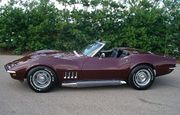
The third generation Corvette (C3) was patterned after the Mako Shark II concept car. The C3 was introduced for the 1968 model year and lasted to 1982. It sold in record numbers despite changes due to EPA regulations and the gas crisis of the 1970s. It introduced monikers that were later revived, such as LT-1, ZR-1, and Collector Edition. The Corvette's 25th anniversary was celebrated in 1978 with a two-tone Silver Anniversary Edition and an Indy Pace Car replica edition. It was the first time that a Corvette was used as a Pace Car for the Indianapolis 500.
Engines and chassis components were mostly carried over from the C2, but the body and interior were new. The 350 cu in (5.7 L) engine replaced the 327 cu in (5.36 L) as the base engine in 1969, but power remained at 300 bhp (224 kW). 1969 was the only year for a C3 with factory installed side exhaust, and the only year the all-aluminum ZL1 427 cu in (7.00 L) was offered; The special big-block engine was listed at 430-hp (320 kW), but was reported to produce 550 horsepower (410 kW) and propelled a ZL1 through the 1/4 mile in 10.89 seconds[9]
In 1970 small-block power peaked with the optional high compression, high-revving LT-1 which produced 370 bhp (276 kW). The ZR1 special engine package was an option available on the 1970 through 1972 model years, and included the LT-1 engine option and special racing equipment. Only 53 ZR1's were built.[10] The 427 cu in (7.00 L) big-block was enlarged to 454 cu in (7.44 L) in 1970, and 1971 was the LS6 454 big-block's peak in power with the 425 bhp (317 kW) rating. Sales dropped sharply for the model year, down nearly 60%, to 17,316.[11]
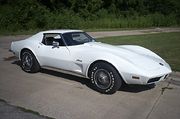
In 1971, engine compression ratios were lowered for the use of low-lead and unleaded fuels, and reduced power ratings resulted. GM moved to the SAE Net measurement in 1972 with further reduced, but more realistic power ratings than the previous SAE Gross standard. The 1972 model's base 350 cu in (5.7 L) was down to 200 bhp (150 kW). 1974 models had the last true dual exhaust system which was dropped on the 1975 models with the introduction of the federally mandated catalytic converter. As a result, engine power plummeted with the base ZQ3 engine producing just 165 bhp (123 kW), the optional L82's output was reduced to 205 bhp (153 kW), and the 454 big-block engine was discontinued. Gradual power increases after 1975 peaked with the 1980 model's optional L82 producing 230 bhp (172 kW).
Styling changed subtly over the generation and minor trim changes occurred through 1972. The Sting Ray nameplate was not used on the 1968 model but Chevrolet still referred to the Corvette as a Sting Ray, and 1969 through 1976 models used the "Stingray" name as one word, without the space. The optional wire-spoked wheel covers (left) were offered for the last time in 1973. Due to the government regulation, the 1973 Corvette's chrome front bumper was changed to a 5-mile-per-hour (8 km/h) system with a urethane bumper cover.
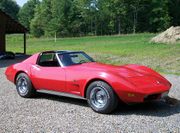
In 1974 a 5-mile-per-hour (8 km/h) rear bumper system with a two-piece, tapering urethane bumper cover replaced the Kamm-tail and chrome bumper blades, and matched the new front design from the previous year. 1975 was the last year for the convertible, (which did not return for 11 years) and Dave McLellan succeeded Zora Arkus-Duntov as the Corvette's Chief Engineer.[12] For the 1976 models the fiberglass floor was replaced with steel panels to provide protection from the catalytic converter's high operating temperature and the Stingray nameplate was dropped after 1976 ending 13 model years where the names Corvette, Sting Ray, and Stingray were synonymous. 1977 was last year the tunneled roof treatment with vertical back window was used, in addition leather seats were available at no additional cost for the first time. The black exterior color returned after a six-year absence, a.[13] The 1978 model introduced the fastback glass rear window and featured a new interior and dashboard. Corvette's 25th anniversary was celebrated with the Indy 500 Pace Car limited edition and a Silver Anniversary model featuring silver over gray lower body paint. All 1979 models featured the previous year's pace car interior and offered the front and rear spoilers as optional equipment. In 1980, the Corvette received an integrated aerodynamic redesign that resulted in a significant reduction in drag . In mid-1981 production shifted from St. Louis, Missouri to Bowling Green, Kentucky, and several two-tone paint options were offered. In 1982 a fuel-injected engine returned, and a final C3 tribute Collectors Edition featured an exclusive, opening rear window hatch.
C4 generation (1984-1996)
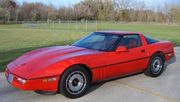
The fourth generation Corvette began production in March 1983 as a 1984 model and ended with the 1996 model. 44 prototype 1983 models were completed. The 23rd produced is displayed at the National Corvette Museum in Bowling Green, Kentucky.
In 1981, GM's Chevrolet initiated plans to change the Corvette for 1983. Due to engineering problems and technology issues, the redesigned Corvette did not hit showroom floors until the middle of that year, and was designated a 1984 model. The 1984 C4 was a completely redesigned Corvette except for its engine, and the emphasis was on handling with the introduction of the front transverse composite leaf spring (still used today). This handling focus came with the penalty of a harsh, uncompromising ride.
This first year C4 carried over the 350 cu in (5.7 L) L83 V8 engine from the 3rd generation Corvette. The L83 had a unique fuel delivery method dubbed "Crossfire": a dual throttle-body injection system. With the first major body, chassis and suspension change since 1963, the new C4 coupe incorporated a rear glass hatch for much improved cargo access, all new brakes with aluminum calipers, an all aluminum suspension for weight savings and rigidity, and the first one piece targa top with no center reinforcement. It came standard with an electronic dashboard with digital liquid crystal displays for the speedometer and tachometer.
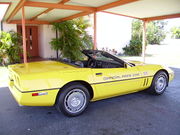
1984 through 1988 Corvettes utilized a "4+3" transmission — a 4-speed manual coupled to an automatic overdrive on the top three gears. It was designed to help the Corvette meet U.S. fuel economy standards. The transmission was problematic and was replaced by a modern ZF 6-speed manual gearbox in 1989. Beginning in 1985, the 230 bhp (170 kW) L98 engine with tuned port fuel injection was the standard engine.
In 1986 the 2nd Corvette Indy Pace Car was released. It was the first convertible Corvette since 1975. It was also the first pace car fast enough in stock form to pace the Indianapolis 500. A Center High Mounted Signal Light (CHMSL, a third center brake light) was added in 1986 to comply with federal law. All 1986 convertibles had an Indy 500 emblem mounted on the console making any color a pace car edition. The color of the actual pace car (used in the race) was yellow.
In 1987, the B2K twin-turbo option became available from the factory. The Callaway Corvette was a Regular Production Option (RPO B2K). The B2K option coexisted from 1990 to 1991 with the ZR-1 option, which then replaced it.
Early B2Ks produced 345 bhp (257 kW) and 450 lb·ft (610 N·m);[14] later versions boasted 450 bhp (336 kW) and 613 lb·ft (831 N·m).[15]
1988 saw the 35th Anniversary Edition. Each of these featured a special badge with an identification number mounted next to the gear selector. These Corvettes were easily identified with their white exterior, wheels and interior.
In 1991, all Corvettes received updates to the body, interior, and wheels. The convex rear fascia that set the 1990 ZR-1 apart from the base model was now included on L98 Corvettes, making the styling of the expensive ZR-1 even closer to that of the base cars. The most obvious difference remaining between the base and ZR-1 models besides the wider rear wheels was the location of the CHMSL (center high mounted stop lamp), which was integrated into the new rear fascia used on the base model, but remained at the top of the rear-hatch on the ZR-1's.

For the 1992 model year, the 300 bhp (220 kW) LT1 engine was introduced, an increase of 50 bhp (37 kW) over 1991's L98 engine. Also new for 1992 was Acceleration Slip Regulation (ASR), a form of traction control which utilized the Corvette's brakes, spark retard and throttle close-down to prevent excessive rear wheel spin and possible loss of control. The traction control device could be switched off if desired.
1993 saw a special 40th Anniversary Edition featuring a commemorative Ruby Red color, 40th anniversary badges and embroidered seat backs. The 1993 Corvette also marked the introduction of the Passive Keyless Entry System, the first GM car to feature it. Production of the ZR-1 ended in 1995, after 6,939 cars had been built.
1996 was the final year of C4 production, and featured special models and options, including the Grand Sport and Collector Edition, OBD II (On-Board Diagnostics), run flat tires, and the LT4 engine. The 330 bhp (246 kW) LT4 V8 was available only with a manual transmission, while all 300 bhp (224 kW) LT1 Corvettes used automatic transmissions.
Chevrolet released the Grand Sport (GS) version in 1996 to mark the end of production of the C4 Corvette. The Grand Sport moniker is a nod to the original Grand Sport model produced in 1963. A total of 1,000 GS Corvettes were produced, 810 as coupes and 190 as convertibles. The 1996 GS came with the high-performance LT4 V8 engine, producing 330 bhp (246 kW) and 340 lb·ft (460 N·m). The Grand Sport came only in Admiral Blue with a white stripe down the middle, and black wheels and two red stripes on the front left wheel arch added to its distinctive look. ( You could also order the GS in white with an Admiral Blue stripe, much harder to find EDIT)
C5 generation (1997-2004)
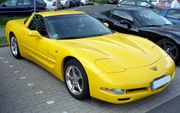
Production of the C5 Corvette began in 1997 and ended with the 2004 model year. The C5 was a major improvement over the long-running C4, which like early Corvettes, tended to develop squeaks and rattles. Chevrolet used cars like the Nissan 300ZX and Mazda RX-7 as benchmarks for quality and styling due to the large amount of criticism the C4 Corvette received when compared to Japanese rivals.[16] The C5 had a top speed of 181 mph (291 km/h) and was judged by the automotive press as improved in nearly every area over the previous Corvette design thanks to its much improved structural rigidity and much more curvaceous design.
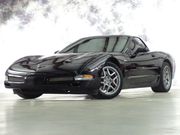
Also introduced with the C5 was GM's new LS1 small block. This third-generation small block was a completely new design, including a distributor-less ignition and a new cylinder firing order. It was initially rated at 345 bhp (257 kW) and 350 lb·ft (470 N·m), but was increased to 350 bhp (260 kW) in 2001. The new engine, combined with the new body and its low 0.29 drag coefficient, resulted in a performance car that was able to achieve up to 28 mpg on the highway.
For its first year, the C5 was available only as a coupe, even though the new platform was designed from the ground up to be a convertible. The convertible returned to the lineup in 1998, followed by the fixed-roof coupe (FRC) in 1999. One concept for the FRC was for it to be a stripped-down model with a possible V6 engine (nicknamed in-house as the "Billy Bob"). It was eventually in 2000 decided to not strip down the model, and the FRC later laid the groundwork for the return in 2001 of the Z06, an RPO option not seen since Zora's 1963 race-ready Corvette.[17]
The Z06 model replaced the FRC model as the highest performance C5 Corvette. Instead of a heavier double-overhead cam engine like the ZR-1 of the C4 generation, the Z06 used an LS6, a 385 bhp (287 kW) derivative of the standard LS1 engine. Using the much more rigid fixed roof design allowed the Z06 unprecedented handling thanks to upgraded brakes and a much less body flex. Those characteristics, along with the use of exotic materials such as a titanium exhaust system and a carbon fiber hood in the 2004 model year, led to further weight savings and therefore performance gains for the C5 Z06. The LS6 was later upgraded to 405 bhp (302 kW) for 2002-2004. Although the Z06's rated power output equal to that of the C4 ZR-1, the improved suspension, rigidity, brakes, and reduced weight of the C5 produced a car much quicker than the previous generation's ZR-1.
C6 generation (2005-present)

Compared to the C5, the C6 Corvette received a larger passenger compartment, all new bodywork with exposed headlamps (for the first time since 1962), reworked suspension geometry, and in 2008, a larger 6.2 L (380 cu in) engine. Overall, it is shorter and narrower than the C5 to gain wider appeal to the European market. The 6.0 L (370 cu in) LS2 V8 produces 400 bhp (300 kW) at 6000 rpm and 424 lb·ft (575 N·m) at 4400 rpm, giving the vehicle a 0-60 time of less than 4.2 seconds
The C6 comes close to retaining the relatively good fuel economy of the C5, due in part to its relatively low .28 drag coefficient and low curb weight, achieving 16/26 mpg (city/highway) when equipped with an automatic transmission. The manual version is the same at 16/26; like all manual transmission Corvettes since 1989, it is fitted with Computer Aided Gear Selection (CAGS) to improve fuel economy by requiring drivers to shift from 1st gear directly to 4th in low-speed/low-throttle conditions. This feature helps the C6 avoid the gas guzzler tax while achieving better fuel economy.[18]
The new Z06 arrived as a 2006 model in the third quarter of 2005. It has a 7.0L version of the small block engine codenamed LS7. At 427.6 cubic inches, the Z06 was the largest small block ever offered from General Motors. Because of the Corvette's former use of 427 cubic-inch big blocks in the late '60s and early '70s, the LS7's size was rounded down to 427 cubic inches. Officially certified output is 505 bhp (377 kW) and has a 0-60 mph (97 km/h) time of 3.8 seconds and a top speed of 198 mph (319 km/h).
For 2008, the Corvette received a mild freshening: a new LS3 engine with displacement increased to 6.2 L (380 cu in), resulting in 430 bhp (321 kW) and 424 lb·ft (575 N·m) (436 bhp (325 kW) and 428 lb·ft (580 N·m) if ordered with the optional performance exhaust). The 6-speed manual transmission also has improved shift linkage and a 0-60 time of 4.0 seconds, while the automatic is set up for quicker shifts giving the C6 automatic a 0-60 time of 4.3 seconds, faster than any other production automatic Corvette. The interior was slightly updated and a new 4LT leather-wrap interior package was added. The wheels were also updated to a new five-spoke design.[19]


The ZR1 was formally announced in a December 2007 press statement by General Motors, where it was revealed that their target of 100 bhp (75 kW) per 1 L (61 cu in) has been reached by a new "LS9" engine with an Eaton-supercharged 6.2-liter engine producing a confirmed 638 bhp (476 kW) and 604 lb·ft (819 N·m). It would have a sticker price of about US US$105,000 with the standard interior or US$115,000 with the leather-wrapped interior. The engine is the most powerful engine to be put into a GM production sports car.[20] Top speed is 205 mph (330 km/h)[21]
In 2010, the historical Grand Sport name returns to the Corvette lineup as an entirely new model series. It combines the wide body from the Z06 with the standard C6 powertrain in both targa coupe and convertible models. With suspension and brake upgrades included, the Grand Sport replaces the Z51 option. A new launch control system was introduced that will allow for more optimal launch in all Corvette models. With launch control, the Grand Sport with a manual transmission is capable of a 0-60 time of four seconds flat.
Starting in the 2011 model year, buyers of the Corvette Z06 and ZR1 are offered the opportunity to assist in the build of their engine. Titled the "Corvette Engine Build Experience," buyers can pay an extra $5,800 to be flown to the Wixom, Michigan Performance Build Center. Participants will help the assembly line workers build the V8 engine, then can accept delivery of the car at the National Corvette Museum in Bowling Green, KY, near the Corvette final assembly point.[22]
Awards
Over the years the Corvette has won awards from automobile publications as well as organizations such as the Society of Automotive Engineers.
Automobile Magazine ranked the 1963–1967 Sting Ray first on their "100 Coolest Cars" list, above the Dodge Viper GTS, the Porsche 911, and others.[23]
Sports Car International placed the Corvette at number 5 on their list of the "Top Sports Cars of the 1960s".
Hot Rod magazine in its March 1986 issue selected the 1973-74 Corvette LS6 454 as one of the "10 most collectable muscle cars" in the company of the 1968-70 Chevelle, 1970 'Cuda, 1970 Challenger, 1966-67 Fairlane, 1968-70 AMX, 1970 Camaro Z28, 1968-70 GTO, 1968-69 Charger, and 1967-68 Mustang.[24]
Car and Driver readers selected the Corvette "Best all around car" nine of 11 years in Car and Driver's Reader's Choice Polls including 1971, 1972, 1973, 1974, and 1975.
Car and Driver magazine selected the Corvette for its annual Ten Best list fifteen times: the C4 from 1985 through 1989, the C5 in 1998, 1999, and 2002 through 2004, and the C6 from 2005 through 2009.
Motor Trend magazine named the Corvette Car of the Year in 1984 and 1998.
Society of Automotive Engineers publication Automotive Engineering International.[25] selected the 1999 Corvette Convertible, (along with the Mercedes-Benz S500) "Best Engineered Car of the 20th century".
The 2005 Corvette was nominated for the North American Car of the Year award and was named "Most Coveted Vehicle" in the 2006 Canadian Car of the Year contest.
U.S. News & World Report[26] selected the 2010 Corvette the "Best Luxury Sports Car for the Money".
Owner demographics
According to research by Specialty Equipment Market Association and Experian Automotive, as of 2009, there were approximately 750,000 Corvettes of all model years registered in the United States. Corvette owners were fairly equally distributed throughout the country, with the highest density in Michigan (3.47 per 1000 residents) and the lowest density in Utah, Mississippi, and Hawaii (1.66, 1.63, and 1.53 registrations per 1000 residents). 47% of them hold college degrees (significantly above the nationwide average of 27%), and 82% are between ages of 40 and 69 (median age being 53).[27]
NASA
Astronaut Alan Shepard, a long time Corvette owner, was invited by then GM Chief Engineer Zora Arkus-Duntov to drive pre-production Corvette models. General Motors executives later gave Sheppard a 1972 model with a Bill Mitchell interior. Jim Rathmann, a Melbourne, Florida Chevrolet dealer and winner of the 1960 Indy 500, befriended astronauts Shepard, Gus Grissom, and Gordon Cooper. Rathman convinced GM President Ed Cole to setup a program which supplied each astronaut with a pair of new cars each year. Most chose a family car for their wives and a Corvette for themselves.[28] Alan Bean recalls Corvettes lined up in the parking lot outside the astronaut offices at the Johnson Space Center in Houston, and friendly races between Shepard and Grissom along the Florida beach roads and beaches themselves as local police turned a blind eye. [29] Shepard, Grissom and Cooper even pulled each other on skis in the shallow water. The Mercury and later astronauts were unofficially tied to the Corvette and appeared in official photographs with their cars and with mock-ups of space vehicles such as the Lunar Module or Lunar Rover. Cooper talked of the races along Cocoa Beach in his eulogy of Shepard at the Johnson Space Center in 1998.[30]
Concept cars
Corvette concept cars have inspired the designs of several generations of Corvettes.[31] The first Corvette, Harley Earl's 1953 EX-122 Corvette prototype was itself, a concept show car, first shown to the public at the 1953 GM Motorama at the Waldorf-Astoria Hotel in New York City on January 17, 1953. It was brought to production in six months with only minor changes.
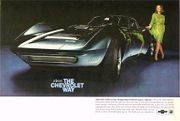
Harley Earl's successor, Bill Mitchell was the man behind most of the Corvette concepts of the 1960s and 1970s. The second-generation (C2) of 1963 was his, and its design first appeared on the Sting Ray racer of 1959. It made its public debut at Maryland's Marlborough Raceway on April 18, 1959, powered by a 283 cu in (4.64 L) V8 with experimental 11:1 compression aluminum cylinder heads and took fourth place. It raced through 1960 wearing only "Sting Ray" badges before retiring to tour the auto-show circuit in 1961.
In 1961 the XP-755 Mako Shark show car was designed as a concept for future Corvettes. In keeping with the name, the streamlining, pointed snout, and other detailing was partly inspired by the look of that very fast fish. The 1961 Corvette tail was given two additional tail lights (six total) for the concept car. The body inspired the 1963 production Sting Ray.
In 1965 Mitchell removed the original concept body and redesigned it as the Mako Shark II. Chevrolet actually created two of them, only one of which was fully functional. The original Mako Shark was then retroactively called the Mako Shark I. The Mako Shark II debuted in 1965 as a show car and this concept influenced Mitchell's redesigned Corvette of 1968.
The Aerovette has a mid-engine configuration using a transverse mounting of its V-8 engine. Zora Arkus-Duntov's engineers originally built two XP-882s during 1969. John DeLorean, Chevy general manager, ordered one for display at the 1970 New York Auto Show. In 1972, DeLorean authorized further work on the XP-882. A near-identical body in aluminum alloy was constructed and became the XP-895 "Reynolds Aluminum Car." Duntov and Mitchell responded with two Chevrolet Vega (stillborn) Wankel 2-rotor engines joined together as a 4-rotor 420 hp (310 kW) engine which was used to power the XP-895. It was first shown in late 1973. The 4-rotor show car was outfitted with a 400 cu in (6.6 L) small-block V8 in 1977 and rechristened Aerovette. GM chairman Thomas Murphy approved the Aerovette for 1980 production, but Mitchell's retirement that year, combined with then Corvette chief engineer Dave McLellan's lack of enthusiasm for the mid-engine design and slow-selling data on mid-engined cars killed the last hope for a mid-engine Vette.
A Corvette Stingray Anniversary concept car was unveiled at the 2009 Detroit Auto Show, fifty years after the Sting Ray racer-concept of 1959.[32] The vehicle was based on a combination of the 1963 Sting Ray and the 1968 Stingray. It appears in the movie Transformers: Revenge of the Fallen, in which it takes the form of character Sideswipe in robot mode.[33]
|
Production notes
| Year | Production | Base Price | Notes |
|---|---|---|---|
| 1953 | 300 | US$3,498 | First generation (C1) begins; production starts on June 30; polo white with red interior and black top is only color combination; Options were interior door handles; "clip in" side curtains were a substitute for roll-up windows. |
| 1954 | 3,640 | US$2,774 | Production moves to St. Louis; exterior colors-blue, red, and black are added; top color-beige is added, longer tail pipes. |
| 1955 | 700 | US$2,774 | Both inline-6 and 265 cu in (4.34 L) V8 engines produced; 3-speed manual transmission added late in the model year. |
| 1956 | 3,467 | US$2,900 | New body with roll-up windows; V8-only; 3-speed manual transmission becomes standard equipment and Powerglide moved to option list. |
| 1957 | 6,339 | US$3,176 | 283 cu in (4.64 L) V8; Optional 4-speed manual and fuel injected engine option added. |
| 1958 | 9,168 | US$3,591 | Quad-headlights and longer, face-lifted body; new interior and dash, fake louvers on hood and chrome strips on trunk lid; number of teeth in grille reduced from 13 to 9. |
| 1959 | 9,670 | US$3,875 | First black interior and dash storage bin; only year with a turquoise top; louvers and chrome strips from '58 removed. |
| 1960 | 10,261 | US$3,872 | Very minor changes to the interior: red and blue bars on the dash logo, vertical stitching on seats |
| 1961 | 10,939 | US$3,934 | New rear styling, bumpers, and round taillights. New fine-mesh grill. |
| 1962 | 14,531 | US$4,038 | 327 cu in (5.36 L) V8 engine; last year with a trunk until 1998. New black grill with chrome surround, chrome rocker panel moldings. |
| 1963 | 21,513 | Second generation (C2) begins;new coupe body style introduced (only year for split rear window); coupe more expensive than convertible | |
| 1964 | 22,229 | US$4,037 | rear backlite windows of coupe changed to single pane window; hood louvers deleted |
| 1965 | 23,562 | US$4,106 | 396 in3 Big-Block V8 added; last year of fuel injected engine option (until 1982-std.); side-discharge exhaust introduced |
| 1966 | 27,720 | US$4,084 | 427 in3 Big-Block V8 with unique bulging hood; 327 in3 300 horsepower (220 kW) small block V8 standard |
| 1967 | 22,940 | US$4,240 | five-louver fenders are unique; Big-Block hood bulge redesigned as a scoop; parking brake changed from pull-out under dash handle to lever mounted in center console; Tri-power 427 would become most sought-after Corvette ever |
| 1968 | 28,566 | US$4,663 | Third generation (C3) begins; New body and T-top removable roof panels, new interior, engines carried over, three-speed Turbo Hydra-matic replaces two-speed Powerglide as automatic transmission option |
| 1969 | 38,462 | US$4,780 | First year of the 350 cu in (5.7 L) Small-Block; longer model year extended to December, 1969 due to delay in introduction of 1970 model; "Stingray" front fender nameplates added, new interior door panels and inserts, 17-inch black-vinyl steering wheel (replaced 18-inch wood-rim wheel) |
| 1970 | 17,316 | US$5,192 | First year for the LT-1 Small-Block and 454 cu in (7.44 L) Big-Block; three-speed manual transmission dropped and four-speed manual became standard with Turbo Hydra-matic available as no-cost option with all engines except LT-1 350; posi-traction made standard equipment; introduced along with all-new second-generation Chevrolet Camaro on Feb. 26, 1970, new egg-grate metal front grills and fender grills, lower molded fender flares, new hi-back seats & interior trim, new custom interior option includes:leather seat trim, cut-pile carpeting, lower-carpeted door panels & wood-grain accents. |
| 1971 | 21,801 | US$5,496 | Significant power drops due to reduced compression ratios to meet GM corporate edict requiring all engines to run low-octane unleaded gasoline; power ratings based on both "gross" and "net" figures with the former based on engine hooked to dynometer while "net" ratings based on power as installed in vehicle with accessories and emission controls installed. |
| 1972 | 27,004 | US$5,533 | Power ratings now advertised in SAE net figures, last year for LT-1 engine, front & rear chrome bumpers, removable rear window, and windshield wiper door. |
| 1973 | 30,464 | US$5,561 | 5 mph (8.0 km/h) front bumper system with urethane cover, pot-metal front grills (black with silver edges), chrome rear bumpers unchanged, new design front fender ducts, first year for radial tires (standard equipment), rubber body mounts, new hood with rear air induction & under-hood insulation, new front-end (round) emblem. cross-flag gas-lid emblem deleted towards the end of the model year. |
| 1974 | 37,502 | US$6,001 | 5 mph (8.0 km/h) rear bumper system with urethane cover to match last year's front bumper, new recessed taillamps and down-turned tail-pipes. 1974 is the only year with two piece rear bumper cover with center-split. No gas lid emblem was used. Aluminum front grills (all-black), dual exhaust resonators added, revised radiator cooling and interior a/c ducts, integrated seat /shoulder belts in coupe. Last year for true dual exhaust system, last year for the 454 big-block engine in a Corvette. |
| 1975 | 38,645 | US$6,810 | First year of Catalytic converter & single-exhaust, black (painted) bumper pads front & rear, redesigned inner-bumper systems & one-piece rear bumper cover, plastic front grills (all-black), amber parking lamp lenses (replaced clear lenses on 73-74) new emblems, last year of C3 convertible. |
| 1976 | 46,558 | US$7,604 | First-year for steel floor-panels, cold-air induction dropped, new aluminum alloy wheels option, new one-piece rear "Corvette" nameplate (replaces letters), last year of "Stingray" fender nameplates. |
| 1977 | 49,213 | US$8,647 | Black exterior available (last year-1969), new design ""Corvette flags" front end & fender emblems. New interior console and gauges, universal GM radios. |
| 1978 | 46,776 | US$9,750 | New fastback rear window, Silver Anniversary and Indy 500 Pace Car special editions; Pace-car included sport seats & spoilers-front & rear, limited option-glass t-tops; redesigned interior, dash, instruments. |
| 1979 | 53,807 | US$10,220 | Sport seats (from the previous year's pace-car); front & rear spoilers optional, glass t-tops optional; New interior comfort features; highest Corvette sales year to date. |
| 1980 | 40,614 | US$13,140 | Lightened materials, new hood, front end with molded spoilers, rear bumper cover with molded spoiler and new tail lamps, Federal government required 85 mph (137 km/h) speedometer; California cars powered by 305 V8 and automatic transmission for this year only, last year for L-82 engine-(n/a with manual transmission) |
| 1981 | 40,606 | US$16,258 | Production is switched from St. Louis to new Bowling Green plant; 350 V8 returns in California cars, last year for manual transmission. |
| 1982 | 25,407 | US$18,290 | New cross-fire fuel-injected L83, New automatic overdrive transmission; Collectors Edition features exclusive hatch rear window - is one fourth of production. |
| 1984 | 51,547 | US$21,800 | Fourth generation (C4) begins; hatchback body; digital instrumentation L83 engine continued from 1982. |
| 1985 | 39,729 | US$24,891 | More powerful and fuel efficient L98 engine introduced. |
| 1986 | 35,109 | US$27,027 | First convertible since 1975. Third brake light, antilock brakes, and key-code anti-theft system are new. |
| 1987 | 36,632 | US$27,999 | Callaway twin-turbo offered through dealers with GM warranty. |
| 1988 | 22,789 | US$29,480 | New wheel design; all white 35th Anniversary special edition coupe. |
| 1989 | 26,412 | US$32,045 | ZF 6-speed manual replaces Doug Nash 4+3. |
| 1990 | 23,646 | US$32,479 | ZR-1 is introduced with DOHC LT5 engine. Interior redesigned to incorporate drivers-side air bag |
| 1991 | 20,639 | US$33,005 | Restyled exterior; last year for the Callaway B2K twin turbo. |
| 1992 | 20,479 | US$33,635 | New LT1 engine replaces the L98; Traction control is standard. |
| 1993 | 21,590 | US$34,595 | Passive keyless entry is standard; 40th Anniversary special edition in Ruby Red. |
| 1994 | 23,330 | US$36,185 | New interior including passenger airbag. |
| 1995 | 20,742 | US$36,785 | Last year of the ZR-1; minor exterior restyling; Indy Pace Car special edition. |
| 1996 | 21,536 | US$37,225 | Optional LT4 engine with 330 bhp (246 kW). Collectors Edition and Grand Sport special editions. First year with OBD II diagnostics. |
| 1997 | 9,752 | US$37,495 | Fifth generation (C5) begins; LS1 engine is new; the hatchback coupé is the only body style offered. |
| 1998 | 31,084 | US$38,995 | Convertible C5 debuts with the first trunk in a Corvette convertible since 1962; Indianapolis 500 Pace Car Replica offered; Active Handling System introduced as optional equipment |
| 1999 | 33,270 | US$39,777 | Less-expensive hardtop coupé is offered. |
| 2000 | 33,682 | US$40,900 | Newly styled alloy wheels debut. |
| 2001 | 35,627 | US$41,475 | Hardtop coupé body style becomes top-performance Z06, utilizing the new LS6 engine and suspension improvements; Second-Generation Active Handling System becomes standard equipment on all models; slight (5 bhp (3.7 kW)) increase in base model engine power |
| 2002 | 35,767 | US$42,450 | 20 bhp (15 kW) increase for the Z06 |
| 2003 | 35,469 | US$45,895 | 50th Anniversary Edition package offered for Coupe and Convertible base models; F55 Magnetic Selective Ride Control Suspension supersedes F45 Selective Ride Control Suspension as base-model option. |
| 2004 | 34,064 | US$46,535 | 24 Hours of Le Mans Commemorative Edition package offered for all models. |
| 2005 | 37,372 | US$44,245 | Sixth generation (C6) begins; New body is first with fixed headlights since 1962; no Z06 model and a late convertible introduction. |
| 2006 | 34,021 | US$43,800 | Z06 debuts; 6-speed automatic with paddle shift available on non-Z06 models. |
| 2007 | 40,561 | US$44,250 | 6-speed automatic paddle shift delays are reduced drastically compared to 2006. |
| 2008 | 35,310 | US$46,950 | Mild freshening, LS3 introduced, All leather interior added (4LT, LZ3). |
| 2009 | 16,956 | US$47,500 | ZR1 model added, new "Spyder" wheels for Z06. |
| 2010 | 12,194 | US$48,930 | Grand Sport Coupe and Convertible added; replaces the Z51 performance package, launch control standard on MN6 models |
Racing
C5-R
The C5-R racer was built by Pratt & Miller for GM Racing. It was based on the C5 road car but had a longer wheelbase, a wider track, an enlarged engine and more aerodynamic bodywork with a rear wing and exposed headlamps. It took part in the American Le Mans Series in the GTS Class and competed in five 24 Hours of Le Mans races as a Corvette Racing entry.
C6-R
In 2005, the factory Corvette Team began racing the C6.R to coincide with the new sixth generation (C6) Corvette being released to the public. Private teams, primarily in Europe, continued to race the C5-R. Corvette C6.R went on to win its class at every race it entered in the 2005 ALMS season.
Indianapolis 500 pace cars
A Corvette has been selected as the pace car at the Indianapolis 500 ten times.[34] The 2008 edition of the Indy 500 represents a record fifth-consecutive year to lead the field. The Corvette's pace car years and details include:
- 1978 – Driven by 1960 race winner Jim Rathmann; Chevrolet produced 6,502 production replicas
- 1986 – Driven by famed pilot Chuck Yeager; all 7,315 production convertibles were considered pace car convertibles and included official graphics (to be installed at the owner's discretion)
- 1995 – Driven by then Chevrolet General Manager Jim Perkins; 527 production replicas produced
- 1998 – Driven by 1963 race winner Parnelli Jones when an injury prevented golfer Greg Norman from performing the duty; 1,158 production replicas produced
- 2002 – Driven by actor Jim Caviezel; no production replicas produced but graphics were available through SPO – approximately 300 sets sold
- 2004 – Driven by actor Morgan Freeman; no production replicas produced
- 2005 – Driven by General Colin Powell; no production replicas produced
- 2006 – Driven by cycling champion Lance Armstrong; first Corvette Z06 pace car; no production replicas produced
- 2007 – Driven by actor Patrick Dempsey; 500 production replicas – all convertibles
- 2008 – Driven by Emerson Fittipaldi; 500 production replicas – coupes and convertibles
Future development
According to Motor Trend GM executives have been planning the next-generation (C7) Corvette since 2007 and have considered front-, mid-, and rear-engine layouts. The car was originally planned for the 2011 model year (to coincide with the 100th anniversary of Chevrolet) but will likely launch as a 2012 model. It may be delayed further, depending on the scope of upcoming CAFE (Corporate Average Fuel Economy) regulations.[35]
The C7 will reportedly feature a new next-gen small block from GM that will include technologies like direct injection, aluminum block and heads and a revised combustion system. The engine will retain the class pushrod configuration and will be reduced in size to only 5.5L. Despite the smaller displacement, the new V8 will produce more horsepower than the current LS3. Currently estimates put the horsepower at 440 hp. The engine for the C7 will be part of the new $890 million small block engine program that will be used in vehicles across the GM lineup.[36]
See also
- Chevrolet Engineering Research Vehicle (CERV)
References
- ↑ Falconer, Tom (2003). The Complete Corvette. Crestline Imprints. p. 9. ISBN 9780760314746. http://books.google.com/?id=KCFqjW2AXTcC&pg=PT14&dq=Corvette++Myron+Scott.
- ↑ quote-The Editors of Consumer Guide
- ↑ Corvette 50th Anniversary by the Editors of Consumer Guide-2003
- ↑ 4.0 4.1 Hot Rod Magazine's Street Machines and Bracket Racing #5 (Peterson Publishing, 1981), p.77.
- ↑ Super Street Cars, 9/81, p.35.
- ↑ Leffingwell, Randy (2002). Corvette Fifty Years. Saint Paul MN USA: MBI Publishing Company. p. 203. ISBN 0-7603-1180-3. http://books.google.com/?id=1CqX-40TnVUC&pg=PA203.
- ↑ Flory, J. "Kelly", Jr. American Cars 1960-1972 (Jefferson, NC: McFarland & Coy, 2004), p.505.
- ↑ Flory, p.509.
- ↑ Corvette 50th Anniversary-specifications and performance-by the Editors of Consumer Guide
- ↑ 1971 Corvette
- ↑ Flory, p.734.
- ↑ http://www.corvettemuseum.com/library-archives/timeline/1970.shtml
- ↑ http://www.corvettemuseum.com/library-archives/timeline/
- ↑ "1987 Twin Turbo Callaway Corvette". http://www.corvetteactioncenter.com/specs/callaway/87tt.html.
- ↑ "1990 Twin Turbo Callaway Corvette". http://www.corvetteactioncenter.com/specs/callaway/90tt.html.
- ↑ >Schefter, James (1998). All Corvettes Are Red. Pocket Publishing. ISBN 978-0671685010. http://www.amazon.com/All-Corvettes-Are-Red/dp/0671685015.
- ↑ Schefter, James (1998). All Corvettes Are Red. Pocket Publishing. p. 96, 105, 108. ISBN 978-0671685010. http://www.amazon.com/All-Corvettes-Are-Red/dp/0671685015.
- ↑ "The Corvette Story". http://www.web-cars.com/corvette/1989.php. Retrieved 2009-02-15.
- ↑ "First Drive: 2008 Chevrolet Corvette". Edmunds.com. April 27, 2007. http://www.edmunds.com/insideline/do/Drives/FirstDrives/articleId=120575. Retrieved November 22, 2008.
- ↑ Marty Jerome (2008-04-25). The Numbers Are In: Corvette ZR1 Cranks Out 638 HP. Wired (Autopia). http://blog.wired.com/cars/2008/04/the-numbers-are.html. Retrieved 2008-04-26
- ↑ "2009 Corvette ZR1 Power Numbers Finalized: LS9 V8 Hits 638 HP!". http://jalopnik.com/383974/2009-corvette-zr1-power-numbers-finalized-ls9-v8-hits-638-hp.
- ↑ "2011 Chevy Corvette Engines Can be Built by Owner". Automoblog.net. http://www.automoblog.net/2010/07/13/2011-chevy-corvette-engines-can-be-built-by-owner/.
- ↑ "Features: 100 Coolest Cars". Automobile Magazine. p. 3. http://www.automobilemag.com/features/0410_coolest_cars/index.html. Retrieved 2008-12-16.
- ↑ Hot Rod-March 1986
- ↑ Best Engineered Car of the 20th Century
- ↑ Deaton, Jamie Page (2009-12-11). "Best Cars for the Money 2010". U.S. News Rankings and Reviews. U.S. News & World Report. http://usnews.rankingsandreviews.com/cars-trucks/best-cars-for-the-money/. Retrieved 2009-12-11.
- ↑ "Vette Owners Quick to Customize". SEMA. 2009-01-15. http://www.sema.org/?q=node/1697. Retrieved 2009-04-22.
- ↑ Bean, Alan. "Training". http://www.alanbean.com/astronaut_training.cfm.
- ↑ Nelson, John (June 2009). "The AstroVette an astronaut's Corvette from the beginning of the Space Age". Vette. http://www.vetteweb.com/features/vet1101_1969_chevrolet_astrovette_stingray/index.html.
- ↑ French, Francis; Colin Burgess, Paul Haney (2009). Into That Silent Sea: Trailblazers of the Space Era, 1961-1965. Bison Books. pp. 261. ISBN 080322639X.
- ↑ Corvette 50th Anniversary-by the Editors of Consumer Guide
- ↑ Friends magazine-published by Chevrolet for Corvette owners
- ↑ Corvette Stingray Concept: Sideswipe In Disguise
- ↑ "Indianapolis 500 Pace Cars". IMS. 2008. http://www.indy500.com/pacecars/. Retrieved 2008-12-16.
- ↑ "No Mid-Engine For Chevrolet Corvette C7". Motor Trend. http://www.motortrend.com/features/auto_news/2008/112_0812_c7_chevrolet_corvette_update/index.html.
- ↑ "C7 Makes a Replacement for Displacement". GMTunerSource.com. http://www.gmtunersource.com/blog/news/item/1085-c7-makes-a-replacement-for-displacement.
- Mueller, Mike. Corvette Milestones. St. Paul, Minnesota: MBI Publishing Co., 1996. ISBN 0-7603-0095-X.
- Nichols, Richard. Corvette: 1953 to the Present. London: Bison Books, 1985. ISBN 0-86124-218-1.
External links
- Chevrolet Corvette (North American site)
- Corvette Europe
- Corvette GM Asia-Pacific-Japan
- Chevrolet Corvette at the Open Directory Project
| Type | 1950s | 1960s | 1970s | 1980s | 1990s | 2000s | 2010s | |||||||||||||||||||||||||||||||||||||||||||||||||||
| 3 | 4 | 5 | 6 | 7 | 8 | 9 | 0 | 1 | 2 | 3 | 4 | 5 | 6 | 7 | 8 | 9 | 0 | 1 | 2 | 3 | 4 | 5 | 6 | 7 | 8 | 9 | 0 | 1 | 2 | 3 | 4 | 5 | 6 | 7 | 8 | 9 | 0 | 1 | 2 | 3 | 4 | 5 | 6 | 7 | 8 | 9 | 0 | 1 | 2 | 3 | 4 | 5 | 6 | 7 | 8 | 9 | 0 | |
| 3-box coupe | C2 | C3 | C5 | |||||||||||||||||||||||||||||||||||||||||||||||||||||||
| Fastback coupe | Collector Edition | C4 | C5 | C6 | ||||||||||||||||||||||||||||||||||||||||||||||||||||||
| Convertible | C1 | C2 | C3 | C4 | C5 | C6 | ||||||||||||||||||||||||||||||||||||||||||||||||||||
| Performance | Fuel Injection | Big Block | ZR-1 | LT4 | Z06 | Z06 | ||||||||||||||||||||||||||||||||||||||||||||||||||||
| L84 | Big Block | LT1 | ZR1 | |||||||||||||||||||||||||||||||||||||||||||||||||||||||
| Motorsports: Grand Sport • GTP • C5-R • C6.R | ||||||||||||||||||||||||||||||||||||||||||||||||||||||||||
